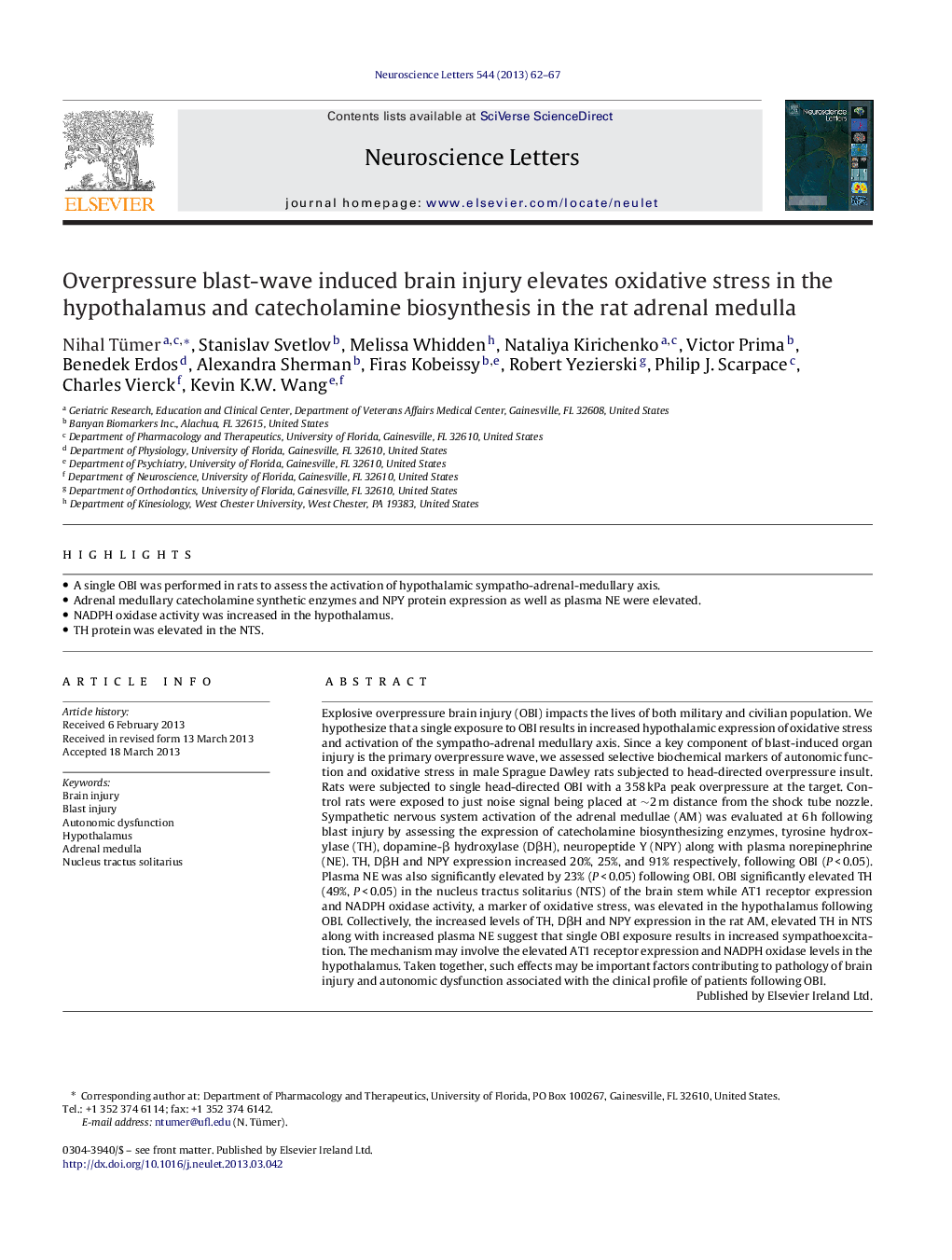| کد مقاله | کد نشریه | سال انتشار | مقاله انگلیسی | نسخه تمام متن |
|---|---|---|---|---|
| 6283366 | 1615154 | 2013 | 6 صفحه PDF | دانلود رایگان |
عنوان انگلیسی مقاله ISI
Overpressure blast-wave induced brain injury elevates oxidative stress in the hypothalamus and catecholamine biosynthesis in the rat adrenal medulla
ترجمه فارسی عنوان
آسیب مغزی ناشی از موج انفجار بیش از حد باعث افزایش استرس اکسیداتیو در هیپوتالاموس و بیوسنتز کاتچولامین در مدولا آدرنال موش صحرایی
دانلود مقاله + سفارش ترجمه
دانلود مقاله ISI انگلیسی
رایگان برای ایرانیان
کلمات کلیدی
موضوعات مرتبط
علوم زیستی و بیوفناوری
علم عصب شناسی
علوم اعصاب (عمومی)
چکیده انگلیسی
Explosive overpressure brain injury (OBI) impacts the lives of both military and civilian population. We hypothesize that a single exposure to OBI results in increased hypothalamic expression of oxidative stress and activation of the sympatho-adrenal medullary axis. Since a key component of blast-induced organ injury is the primary overpressure wave, we assessed selective biochemical markers of autonomic function and oxidative stress in male Sprague Dawley rats subjected to head-directed overpressure insult. Rats were subjected to single head-directed OBI with a 358 kPa peak overpressure at the target. Control rats were exposed to just noise signal being placed at ~2 m distance from the shock tube nozzle. Sympathetic nervous system activation of the adrenal medullae (AM) was evaluated at 6 h following blast injury by assessing the expression of catecholamine biosynthesizing enzymes, tyrosine hydroxylase (TH), dopamine-β hydroxylase (DβH), neuropeptide Y (NPY) along with plasma norepinephrine (NE). TH, DβH and NPY expression increased 20%, 25%, and 91% respectively, following OBI (P < 0.05). Plasma NE was also significantly elevated by 23% (P < 0.05) following OBI. OBI significantly elevated TH (49%, P < 0.05) in the nucleus tractus solitarius (NTS) of the brain stem while AT1 receptor expression and NADPH oxidase activity, a marker of oxidative stress, was elevated in the hypothalamus following OBI. Collectively, the increased levels of TH, DβH and NPY expression in the rat AM, elevated TH in NTS along with increased plasma NE suggest that single OBI exposure results in increased sympathoexcitation. The mechanism may involve the elevated AT1 receptor expression and NADPH oxidase levels in the hypothalamus. Taken together, such effects may be important factors contributing to pathology of brain injury and autonomic dysfunction associated with the clinical profile of patients following OBI.
ناشر
Database: Elsevier - ScienceDirect (ساینس دایرکت)
Journal: Neuroscience Letters - Volume 544, 7 June 2013, Pages 62-67
Journal: Neuroscience Letters - Volume 544, 7 June 2013, Pages 62-67
نویسندگان
Nihal Tümer, Stanislav Svetlov, Melissa Whidden, Nataliya Kirichenko, Victor Prima, Benedek Erdos, Alexandra Sherman, Firas Kobeissy, Robert Yezierski, Philip J. Scarpace, Charles Vierck, Kevin K.W. Wang,
